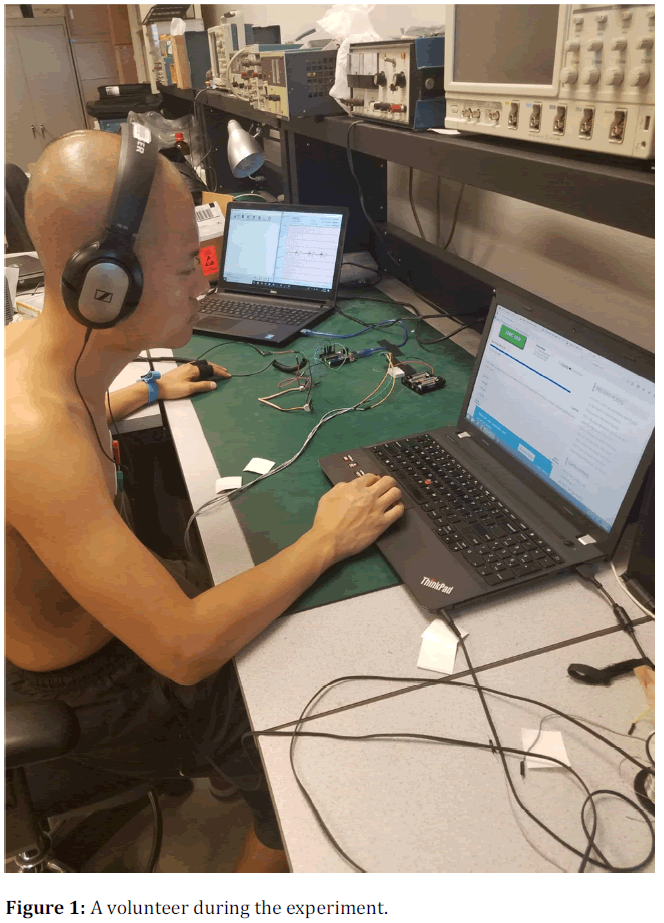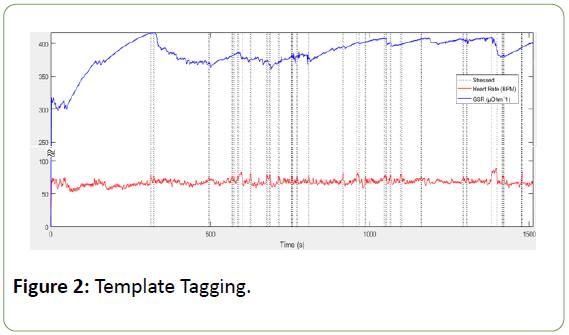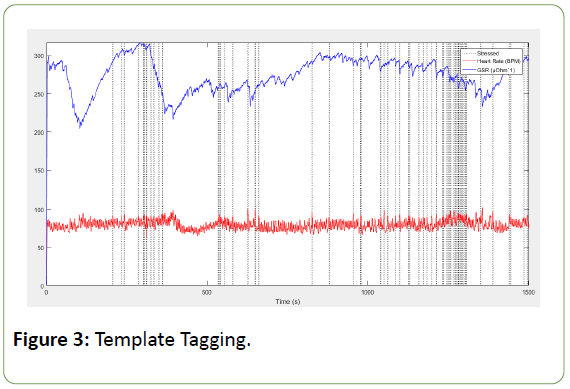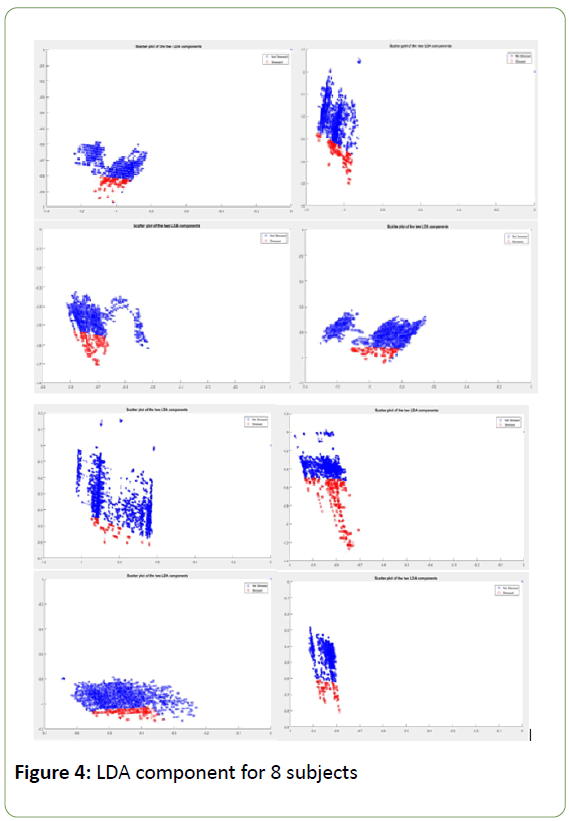Keywords
ECG-Electrocardiogram, GSR-Galvanic skin response, LDA-Linear discriminant analysis, SVM-Support vector machine, MLP-Multilayer perceptron
Introduction
A century ago, the major threats to human existence were tuberculosis, flu, childbirth, and pneumonia [1]. The world we live in today is fast-paced and people seldom die from these diseases. Instead, humans die of diseases that are relatively new, such as heart disease, diabetes, and cancer in addition to accidents and suicide. Most of these diseases are caused by stress or exacerbated by stress. Homeostasis is a state in which an organism is, or groups are, in balance [2]. When applied to humans, homeostasis means there is a level of glucose in the bloodstream that makes the body temperature balanced. With the advancement in technology which has led to the creation of smartphones, smart cars, TVs, and computers which help to reduce human effort, it is only logical to think that we would live a stress-free life. This is clearly not the case. Stressors have increased and have caused low performance in the workforce, diseases, and harm to our wellbeing. A stressor as used here refers to anything outside a human body that moves an individual from its homeostatic balance [3].
Stress is the psychological perception of pressure and how the body responds to this pressure [4]. A stressful event can be caused by an internal or external phenomenon which leads to the release of adrenaline and cortisol. These hormones move through the body causing a change in heart rate, breathing, flow of blood, and level of attention. The effect of stress leads to substandard work, poor health, depression, and sometimes death. It is impossible to avoid stress, but excessive stress can be prevented by accurately measuring and developing a monitoring system to keep track and analyze the various stress hormones released by the body.
The focus of this work is to identify acute stress in order to improve the productivity of individuals. The hormones released by the body during stress can be detected by various sensors such as Electroencephalography (EEG), Electrocardiogram (ECG), and Galvanic Skin Response (GSR). We use multiple sensors simultaneously to increase the accuracy of stress detection [e.g., ECG and GSR] to provide feedback that helps an individual release the stress. An ECG sensor measures the Heart Rate (HR) in beats per minute (bpm) of an individual and the GSR sensor measures the electrical resistance of the skin caused by emotional stress in Siemens. A person undergoing stress undergoes an increase in breathing, heart rate, and palms become moist due to the increase in the sympathetic nervous system which causes an increased hydration in the sweat ducts [3].
There are many sensors designed to measure physiological signals and you can purchase many of these off-the-shelf. The problem with these sensors is that the Signal-to-Noise Ratio [SNR] is not sufficient for an adequate measurement and obtaining a clear understanding of stress measurement using these sensors can be a challenge. This work addresses the collection of reliable data from the fusion of these off-the-shelve sensors and the identification of correlation when using these sensors to measure stress.
Methods
The measurements were conducted at the Bioinstrumentation Laboratory in the Department of Electrical and Computer Engineering at The University of Arizona. The workstation was grounded to prevent electrostatic discharge that may interfere with the data collection. The sensors used were BMD 101 module with a power source, Groove GSR sensor v1.2, and an Arduino UNO. The BMD 101 Module connects to a laptop via Bluetooth.
Our skin provides information on how we feel when we are exposed to emotionally loaded images, videos, events, or other kinds of stimuli [5]. No matter whether we are stressed, nervous, fearful, psyched up or surprised-whenever we are emotionally aroused, the electrical conductivity of our skin subtly changes [6]. One of the most sensitive measures for emotional arousal is GSR. With the aid of ECG and GSR sensors in data collection, the Linear Discriminant Analysis (LDA) is used as a stress detection algorithm and the Support Vector Machine (SVM) is used as the classifier of the stressed and unstressed states. Finally, the multilayer perceptron is used to verify the results obtained from SVM. In these studies, the BMD 101 module was used. Since humans react differently to the same event, this work models everyone separately thereby providing a scale to differentiate an individual’s reaction to the stressor.
Volunteers were students and staff at The University of Arizona, resulting in a total of 24 males and a female. The ages of the subjects ranged from 21 to 70 years, with an average of 28.92 and a standard deviation of 12.11. All the subjects were healthy and some of them were athletic. Arousing stress in an individual necessitates a well-defined experiment in order to obtain an arousal to the specific stressor and for comparison to other individuals. This work induces stress by using a test anxiety strategy [7]. Test anxiety is a combination of physiological overarousal, tension and somatic symptoms, along with worry, dread, fear of failure, and insufficient performance that occur before or during test situations [8]. It is a physiological condition in which people experience extreme stress, anxiety, and discomfort during and before taking a test [9]. Test anxiety can also be labeled as anticipatory anxiety, situational anxiety or evaluation anxiety [9].
Data was collected for 25 minutes from 25 subjects. Every subject read and signed the consent form according to The University of Arizona Institutional Review Board. Every participant was instructed on the specific manner in which the answers should be recorded.
The subject was given three ECG electrodes to place close by the heart, one on the right side of the heart, the other on the left side, while the last electrode was placed below (about 5cm) the left electrode. The electrostatic discharge strap was placed on the subject’s hand. ECG connectors were then connected to the electrodes on the subject’s chest.
The subject’s hand was swabbed with water to ensure a good connection for the GSR sensor. The GSR sensor was connected to the index and middle finger of the left hand and the subject was instructed not to make any large or sudden movement with that hand during the experiment.
After all the probes are placed, ECG data and GSR data are checked for accuracy (to make sure all the waveforms are appropriate for the system). Data is then recorded.
For the first 5 minutes, the subject listens to music (Vivaldi Four Seasons) on YouTube in order to measure the baseline for a non-stressed condition (Figure 1). The next 5 minutes, the subject takes the Montreal Imaging Stress Task (MIST) [10] which is a mathematics test comprising addition, subtraction, multiplication, and division [https://wonderlictestsample.com/50-question-wonderlic-test/].

Figure 1: A volunteer during the experiment.
After the MIST, the subject takes the Wonderlic Test WT [10] which is used by many employers and educational facilities to assess their candidates. The test consists of mathematical questions, English questions, and general knowledge questions. The subject answers 50 questions in 12 minutes and is graded according to the correctness of the questions answered. Finally, for the last 3 minutes, the subject continues to listen to music. The data was stored in a computer for later analysis.
Template extraction
Combining both the physiological signals and the different non-stressing and stressing tasks explains how the template is created. The template extraction is required so that the system can create a profile in order to determine whether a subject is actually undergoing stress or not. This template is based on specific characteristics extracted from a subject with respect to parameters from the physiological signals HR and GSR.
Since the different states of stressed and non-stressed cannot be controlled by an individual, the system must know how both signals behave in both situations. The first step consists of extracting a relaxed state template from the user, this template shows the behavior of the GSR and HR data in the relaxed state. The second step consists of extracting the stressed state template. Finally, the third state comprises getting the relaxed state of the subject after all the stressors have been applied. The final state involves the fact that after a stressor, HR and GSR require more time to achieve a calm state. Therefore, the first and third state diverge in terms of HR and GSR despite the fact that the subject is doing the same task [8].
In a non-stressed state, the HR of a human ranges from 40-60 bpm for an athletic person and from 80-100 bpm for a regular individual [11]. The GSR values for humans are affected by a range of factors, so there is no concrete range of value for a human. Instead, what is important is the trend of data changes [9]. Once a baseline value for both HR and GSR are achieved, the system is modelled to pick a value of 10-15 bpm above the baseline value for HR data, and a value of 40-50 Siemens below the baseline value for the GSR data (simultaneously) and categorize it as a stressed state, thereby making the model specific to individuals. Below is an image showing how the template was made (Figure 2 and Figure 3).

Figure 2: Template Tagging.

Figure 3: Template Tagging.
As shown in the images (Figure 2 and Figure 3), specific points corresponding to the various stressors are picked up by the model and these points fall basically when the stressor is active.
Classification techniques
Linear discriminant analysis: The LDA method is a generalization of Fisher’s linear discriminant and is used in statistics, pattern recognition, and machine learning to find a linear combination of features that characterizes two or more classes of events [12]. The result may be used as a linear classifier or dimensionality reduction (which is the use in this case). A hyperplane in the p-dimensional attribute space is used to separate the known classes, points are then classified according to what side they fall on in the hyperplane. The linear discriminant analysis was defined for the case of two classes by letting x, x1, x2 be the respective means of attribute vectors over the two classes, with a coefficient set a1, …, ap. Consider a set of observations x → {displaystyle {vec {x}}} (also called features, attributes, variables or measurements) for each sample of an object or event with known class [14]y {displaystyle y}. This set of samples is called the training set. The classification problem is then to find a good predictor for the class y {displaystyle y} of any sample of the same distribution (not necessarily from the training set) given only an observation [14]x→ {displaystyle {vec {x}}} .
Figure 4 shows the linear discriminant analysis of 8 of the volunteers, a stressed stage is in red, while the non-stressed state is in blue.

Figure 4: LDA component for 8 subjects
Support vector machine: Support vector machines are supervised learning models used for classification and regression analysis [13]. SVM classifiers are used to predict future trends. The main idea of SVM is to find an optimal hyperplane that maximizes the margin between two groups of samples. In using the SVM classifier, two steps were used: some part of the data are selected randomly and trained as the SVM classifier and in the second step, the trained data is used to classify the rest of the data. 5000 samples of the data are selected randomly for testing and another 5000 for training.
Multilayer perceptron: Multilayer perceptron is a class of feedforward artificial neural networks [18]. It consists of at least three layers of nodes (input, hidden layers, and output), and except for the input node, each node is a neuron that uses a nonlinear activation function [6]. MLP utilizes a supervised learning technique called backpropagation for training [6].
Results
A stress detection system must reach a compromise between detecting properly which individuals are under stress situations, and which individuals are in a relaxed state [1]. Two assessment parameters are used. True Stress Detection (TSD) is when the system properly detects stress when an individual is under stress stimuli. It is modeled as:

Where a true positive means classifying as stressed an individual which is stressed, and a false negative means classifying as relaxed an individual which is under stressing situations.
True Non-Stress Detection rate (TNSD) is when the system correctly detects no stress in an individual and the subject is not under stressing situations. TNSD is modeled as:

Where a true negative means classifying as non-stressed as an individual which is not under stress, and false positive means classifying as stressed an individual which is relaxed. Table 1 shows the results from all 25 subjects.
| Subject |
TSD for MLP |
TNSD for MLP |
TSD for SVM |
TNSD for SVM |
| 1 |
89.9 |
100 |
87.8 |
100 |
| 2 |
85.75 |
100 |
84.97 |
100 |
| 3 |
88.39 |
100 |
84.36 |
100 |
| 4 |
85.84 |
100 |
85.82 |
100 |
| 5 |
86.95 |
100 |
82.95 |
100 |
| 6 |
85.3 |
100 |
80.24 |
100 |
| 7 |
87.46 |
100 |
86.25 |
100 |
| 8 |
90.05 |
100 |
88.98 |
100 |
| 9 |
87.8 |
100 |
88.67 |
100 |
| 10 |
92.23 |
100 |
91.78 |
100 |
| 11 |
89.74 |
100 |
87.34 |
100 |
| 12 |
86.56 |
100 |
86.32 |
100 |
| 13 |
90.75 |
100 |
90.45 |
100 |
| 14 |
91.32 |
100 |
89.61 |
100 |
| 15 |
88.98 |
100 |
88.35 |
100 |
| 16 |
89 |
100 |
89.34 |
100 |
| 17 |
87.64 |
100 |
86.45 |
100 |
| 18 |
85.01 |
100 |
86.32 |
100 |
| 19 |
88.65 |
100 |
87.44 |
100 |
| 20 |
86.89 |
100 |
86.7 |
100 |
| 21 |
89.45 |
100 |
88.75 |
100 |
| 22 |
88.78 |
100 |
88.6 |
100 |
| 23 |
87.65 |
100 |
87.65 |
100 |
| 24 |
92.57 |
100 |
91.88 |
100 |
| 25 |
89.32 |
100 |
89.45 |
100 |
Table 1: Results showing the accuracy using the different methods.
Conclusions
The main objective of this work is to investigate the efficacy of the fusion of data from off-the-shelf sensors to accurately determine stress in humans. While several techniques were used to solve this problem (linear discriminant analysis, support vector machine and multilayer perceptron). The multilayer perceptron method gave the best accuracy when classifying both data.
23380
References
- de Santos Sierra A, Ávila CS, Casanova JG, del Pozo GB (2011) A stress-detection system based on physiological signals and fuzzy logic. IEEE Trans Ind Electron 58: 4857-4865.
- Crifaci G, Billeci L, Tartarisco G, Balocchi R, Pioggia G, et al. (2013) ECG and GSR measure and analysis using wearable systems: Application in anorexia nervosa adolescents. InImage and signal processing and analysis (ISPA), IEEE: 499-504.
- Bakker J, Pechenizkiy M, Sidorova N (2011) What's your current stress level? Detection of stress patterns from GSR sensor data. InData Mining Workshops (ICDMW), IEEE: 573-580.
- Andrews B, Wilding JM (2004) The relation of depression and anxiety to life-stress and achievement in students. Br J Psychol 95: 509-521.
- Zeidner M (1998) Test anxiety: The state of the art. Springer Science & Business Media.
- Vaez M, Laflamme L (2008) Experienced stress, psychological symptoms, self-rated health and academic achievement: A longitudinal study of Swedish university students. Soc Behav Pers 36: 183-196.
- Fisher RA (1936) The Use of Multiple Measurements in Taxonomic Problems. Ann Eugen 7: 179-188.
- Cortes C, Vapnik V (1995) Support-vector networks. Mach Learn 20: 273-297.
- Villarejo MV, Zapirain BG, Zorrilla AM (2012) A stress sensor based on Galvanic Skin Response (GSR) controlled by ZigBee. Sensors 12: 6075-6101.
- Rumelhart DE, Hinton GE, Williams RJ (1985) Learning internal representations by error propagation. California Univ San Diego La Jolla Inst for Cognitive Science.
- Cybenko G (1989) Approximation by superpositions of a sigmoidal function. Mathematics of control, signals and systems 2: 303-314.
- Lowe PA, Ang RP (2012) Cross-cultural examination of test anxiety among US and Singapore students on the Test Anxiety Scale for Elementary Students (TAS-E). Educ Psychol 32: 107-126.
- McLachlan G (2004) Discriminant analysis and statistical pattern recognition. John Wiley & Sons.











